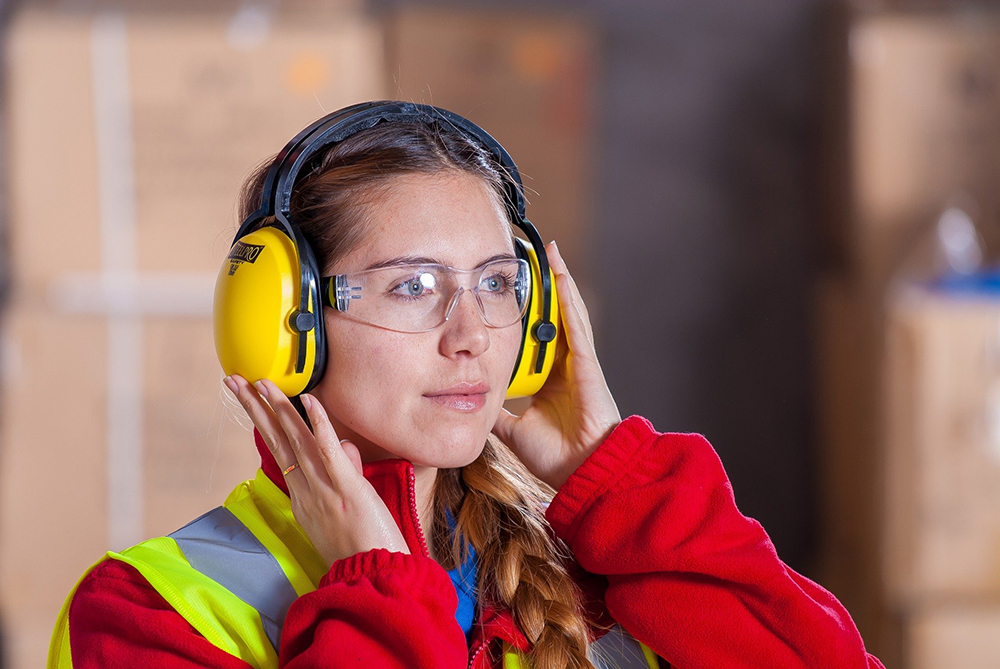Eye Injuries at Work
The National Institute for Occupational Safety and Health (NIOSH) reports every day approximately 2,000 U.S. workers sustain job-related eye injuries requiring medical treatment. Safety experts and eye doctors know that the right eye protection can and will lessen the severity or even completely prevent 90% of eye injuries. March is Eye Health Safety in the Workplace Month and we are working to educate both employers and employees about how to eye injury in the workplace.
Potential Eye Hazards at Work
The American Optometric Association recommends that eyewear be worn when the following hazards are present at your workplace:
- Projectiles (dust, concrete, metal, wood and other particles).
- Chemicals (splashes and fumes).
- Radiation (especially visible light, ultraviolet radiation, heat or infrared radiation, and lasers).
- Bloodborne pathogens (hepatitis or HIV) from blood and body fluids.
According to the AOA, some working conditions include multiple hazards but the proper eyewear protection takes that into consideration. The type of safety eye protection you should wear depends on the hazards in your workplace:
- If you are working in an area that has particles, flying objects or dust, you must at least wear safety glasses with side protection (side shields).
- If you are working with chemicals, you must wear goggles.
- If you are working near hazardous radiation (welding, lasers or fiber optics) you must use special-purpose safety glasses, goggles, face shields or helmets designed for that task.
Occupations with a High Risk for Eye Injury:
- Construction
- Carpentry
- Auto Repair
- Mining
- Plumbing
- Welding
- Manufacturing
- Electrical Work
- Computer Work*
The type of safety eye protection you should wear depends on the hazards in your workplace:
- If you are working in an area that has particles, flying objects or dust, you must at least wear safety glasses with side protection (side shields).
- If you are working with chemicals, you must wear goggles.
- If you are working near hazardous radiation (welding, lasers or fiber optics) you must use special-purpose safety glasses, goggles, face shields or helmets designed for that task.
Know the requirements for your work environment. Side shields placed on your conventional (dress) glasses do not provide enough protection to meet the OSHA requirement for many work environments.
For more helpful eye care and vision care tips, please visit our main blog page.
Sources: www.aoa.org
Image by Yerson Retamal from Pixabay


Experience performance biking gear at bicycle gear store.
Find all your cycling needs in one cycling shop.
Your reliable source for everything cycling: cycling store online.
Where every cyclist shops: bicycle gear store.
Push your limits with help from bicycle gear store.
Discover great deals today at our online bike gear shop.
Your reliable source for everything cycling: cycling store online.
Enjoy your smooth commute with road bike accessories.
Excellent site you have got here.. It’s difficult to find excellent writing like yours nowadays. I seriously appreciate individuals like you! Take care!!
Very good post! We will be linking to this particularly great content on our website. Keep up the great writing.
lồn múp
Explore top-quality gear now at cycling gear.
Buôn Lậu Ma Túy
Find trusted brands and expert picks at bicycle gear store.
Enjoy your smooth commute with road bike accessories.
phim sex gay
web sex gái gọi
http://www.eto.uk.com bảo mật kém, dễ bị đánh cắp thông tin cá nhân
Way cool! Some extremely valid points! I appreciate you penning this write-up and the rest of the site is really good.
You need to take part in a contest for one of the finest blogs on the internet. I most certainly will highly recommend this web site!
Khám phá KU88 – nhà cái có mặt trên thị trường quốc tế với giao diện thân thiện và nhiều tính năng hiện đại: https://ku88.uk.net/
hiếp dâm tập thể
phim khiêu dâm miễn phí
Ride in style with accessories from bicycle gear store.
Enjoy your smooth commute with road bike accessories.
займ на карту без отказа без проверки займ на карту без отказа без проверки .
онлайн кредит круглосуточно без отказа онлайн кредит круглосуточно без отказа .
KU88 – Nhà cái uy tín hàng đầu với kho trò chơi đa dạng, bảo mật cao, nạp rút nhanh chóng. Truy cập ngay: https://ku88.uk.net/
This website was… how do I say it? Relevant!! Finally I have found something that helped me. Thanks a lot!
Find all your cycling needs in one cycling shop.
Get the best value on tools and kits at bike tools and equipment.
Hi! I could have sworn I’ve visited this web site before but after going through some of the articles I realized it’s new to me. Anyhow, I’m definitely happy I came across it and I’ll be book-marking it and checking back often!
Right here is the right blog for everyone who would like to understand this topic. You realize so much its almost hard to argue with you (not that I really would want to…HaHa). You definitely put a fresh spin on a subject that’s been discussed for a long time. Excellent stuff, just great.
phim sex học sinh
I like reading a post that can make people think. Also, thanks for permitting me to comment.
I couldn’t resist commenting. Very well written!
phim sex học sinh
Spot on with this write-up, I really believe this web site needs a great deal more attention. I’ll probably be back again to read more, thanks for the advice!
Greetings! Very helpful advice in this particular article! It’s the little changes which will make the most important changes. Thanks a lot for sharing!
психологическая клиника нижний новгород психологическая клиника нижний новгород .
You have made some decent points there. I looked on the net to learn more about the issue and found most people will go along with your views on this website.
cặc dài
This blog was… how do I say it? Relevant!! Finally I have found something that helped me. Kudos.
Hiếp dâm trẻ em, loạn luân, ấu dâm
Hiếp dâm trẻ em, loạn luân, ấu dâm
Hiếp dâm trẻ em, loạn luân, ấu dâm